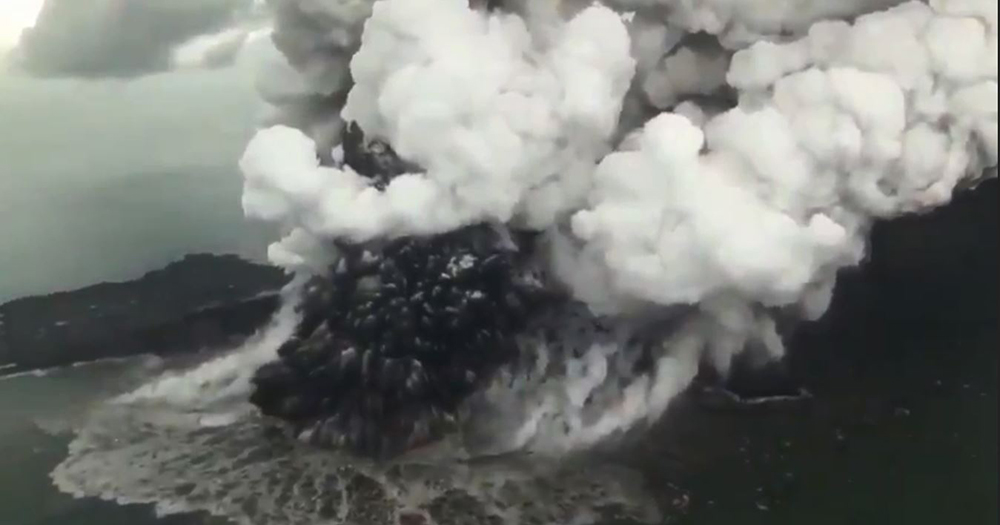The volcanic island of Anak Krakatoa, situated within the Sunda Strait, recently made the news in December 2018 due to the devastating tsunami it caused.
The BBC reported that the number of casualties has risen to 429 as of Dec. 26.
The Indonesian National Board for Disaster Management, Sutopo Purwo Nugroho, has also warned of more tsunamis that could be triggered by the continuing eruptions at the island.
Why is the volcano so deadly?
Anak Krakatoa means "Child of Krakatoa" and, according to the BBC, emerged from the sea in 1927, at the site of the underwater caldera formed by the original eruption.
The initial eruption had occurred in August 1883 and is widely considered one of the world's deadliest volcanic disasters in recorded history, due to its incredible force.
Here are some of the most noteworthy facts about the eruption, according to the book Krakatoa: The Day the World Exploded: August 27, 1883, by British-American journalist Simon Winchester:
- Tsunamis of up to 41m were generated, killing close to 36,000 people in the Sunda Straits and were detected as far as Cape Town, South Africa.
- The loudest sound ever recorded on Earth was also generated, with the eruption heard as far as the island of Rodrigues in the Indian Ocean, at a distance of 2,968 miles (4,777km) from Krakatoa.
- The ash cloud from the eruption shot high into the atmosphere, with the lightest material -- sulfuric aerosols -- reaching a height of 30 miles (48km).
- Meanwhile, denser material fell as far as the Horn of Africa, 3,700 miles (5,954km) away.
- The sulfuric aerosols refracted and filtered sunlight, lowering global temperatures by about nearly a degree.
- It also altered the sky's colours worldwide.
- In total, the eruption's energy came up to 200 megatons of TNT, around 13,000 times the force of the atomic bomb dropped on Hiroshima.
Considering that Singapore is only 840km away from the island, the eruption was very much heard and felt in Singapore as well, with both Winchester's book and an eyewitness letter to the Manchester Guardian, in Dec. 19, 1883, testifying to its effects here.
Explosive noises and ash in Singapore
Perhaps the most vivid account of the eruption in Singapore comes from Winchester's compilation of several reports, which stated that "thudding sounds" could be heard here as "audible evidence of the explosions".
These explosive sounds are also referenced in the letter which stated "a noise as if a very heavy bombardment was going on" could be heard at the southern end of the Straits of Malacca.
In fact, so great were these sounds that communicating by telephone became effectively impossible during the eruption.
Winchester highlighted:
"In Singapore it became impossible, on one set of telephone lines, to hear yourself speak, since 'a perfect roar, as of a waterfall, was heard, and by shouting at the top of one's voice the clerk at the other end heard the voice, but not a single sentence was understood. The same noise... was noticed on every line here.'"
This was not the only direct impact on Singapore. Ash from the eruption also fell over our island.
According to the eyewitness letter, written by a passenger on board a ship which had docked in Singapore, "particles of fine dust" had continuously covered the ship's decks for two days.
The eyewitness also recalled another "steamer in harbour which had been newly painted during the day", and was subsequently "found to be covered with thick dust, which had adhered to the new paint".
The letter further added that "a number of shocks were felt" during his stay as well, suggesting the presence of earthquakes.
Sky turned green
Of significance too is the eyewitness' account of both sea and sky regionally turning a "vivid green colour", like that of a "well kept grass lawn".
The eyewitness noted that this made sunsets and sunrises in particular "indescribably beautiful", as they would be "tinged with every shade of green not simply at the place of rising and setting, but thrown back on the rolling clouds all around the horizon".
This account is backed up by Winchester's book stating that the sulfuric aerosols thrown into the atmosphere from the ash was responsible for such effects and was a phenomenon that spread far beyond Southeast Asia as the aerosols disseminated worldwide.
In Europe and North America, Winchester stated that the sky turned into varying shades of red, such as those of "vermilions and passion fruits and carmines and royal mauves", inspiring multiple artists and poets throughout these regions.
The only effect that did not reach Singapore was the tsunami.
Winchester wrote thanks to the "long fingers of shallows and sandbanks and further islets and reefs" east of the island, the tsunami dissipated over them, so much so that the tide meters in Singapore did not register anything at all.
Information on 1883 Krakatoa eruption and its effects based on research done by Simon Winchester in Krakatoa: The Day the World Exploded: August 27, 1883
Top image screenshot of video by Susi Air
If you like what you read, follow us on Facebook, Instagram, Twitter and Telegram to get the latest updates.
